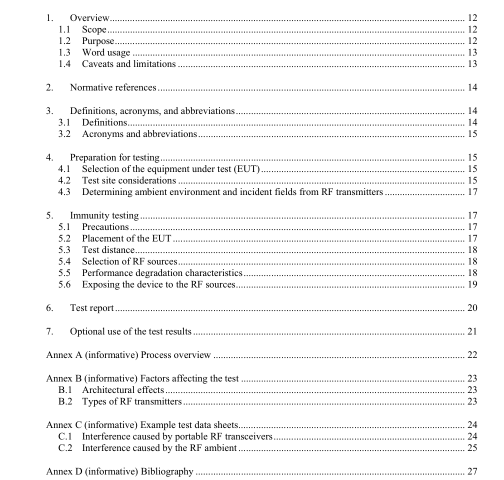IEEE C63.24-2021 pdf download.American National Standard— Recommended Practice for In Situ RF Immunity Evaluation of Electronic Devices and Systems
1.1 Scope
This recommended practice provides a method for in situ immunity testing of electronic devices and systems that are installed and operated at the locations where they are used, as well as where they experience interference.
The primary source of the electromagnetic (EM) energy is from transmitters that are authorized to be used, as they are in compliance with regulatory requirements. Another source is the general ambient EM environment from a variety of sources. The ambient EM environment can be characterized via a site survey using the techniques found in IEEE Std 473™.
In laboratory testing, the product is exposed to RF energy (conducted or radiated) over a wide frequency range.
This cannot be done at the in situ location without a special license from regulators (e.g., the FCC). Hence, it is expected that transceivers with known frequencies allowed by the regulatory authorities are used during testing, such as licensed devices or devices using industrial, scientific, and medical (ISM) frequency bands. This is intended to replicate the immunity experience on-site where these devices/sources have been known already to be the cause of interference.
NOTE—For interference in healthcare facilities, see ANSI C63.18 [B2]. 2, 3
1.2 Purpose
There is a need to evaluate the in situ radio-frequency (RF) immunity of electronic devices and systems. This recommended practice focuses on installation environments that have experienced interference when exposed to portable or ambient RF sources.
System aging is another reason for in situ testing. A number of aging mechanisms can degrade the initial immunity of installed equipment over its operational life. Periodic in situ testing can help verify that the required level of immunity continues to be in place over the operating life of a system. In particular, if interference is exhibited suddenly, the equipment immunity should be re-evaluated using the most recent portable RF devices and the most recent RF ambient at the location where the product is installed.
The test protocol is designed to be performed as follows:
— In a way that is relatively rapid and practical
— To identify specific effects and thresholds (i.e., transmit power and distance) that influence the test results that show undesired degradation to the installed product
— To generate test results that can be used in the formulation of policies and procedures for managing the electromagnetic environment, both for portable transceivers and the RF ambient within a structure
An important function of this recommended practice is to specify a consistent test protocol to allow results to be obtained and compared within and across other similar installations. To facilitate comparison between organizations, it is important that the recommendations herein are followed, deviations are kept to a minimum, documentation is thorough, and the testing is performed as consistently as possible.
Policies and procedures for mitigation of electromagnetic interference (EMI), including use or restriction of specific RF transceivers within specific areas, should be based on objective information, including that obtained by the use of this test method. With regard to purchase evaluation, confirming that devices conform to electromagnetic compatibility (EMC) standards through laboratory type-testing can provide some information. This recommended practice can be used to supplement that information with an evaluation of the actual installed equipment which is subject to a composite EM environment not readily constructed at a test laboratory. The intent of this recommended practice is to provide an evaluation method using available portable transmitters that does not require laboratory testing. It also does not set a recommended minimum level of immunity and instead provides guidance on best practices for mitigation of interference.IEEE C63.24 pdf downlaod.IEEE C63.24-2021 pdf download
IEEE C63.24-2021 pdf download

Leave a Reply